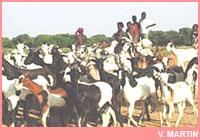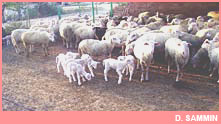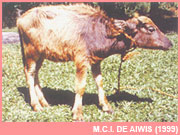|
INSIDE
Avian Influenza
Avian influenza situation in Asia, as of January 2005
Can a pandemic strain be predicted?
Inception workshop for project TCP/RAS/3007 (E)
Rift Valley fever
Improving the capacity of veterinary services
Rift Valley fever surveillance in West Africa in 2004
Conclusion
Peste des petits ruminants
FAO mission to follow up outbreaks of peste des petits ruminants (PPR)
Communication
Update on Haemorrhagic septicaemia and progress in vaccine research
Workshops
TADinfo training workshop in Windhoek, Namibia
News
In brief...
Contributions from FAO reference laboratories and collaborating centres
Stop the press
New staff
EMPRES ADDRESS LIST |
Rift Valley fever surveillance in West Africa in 2004
 Four years after the close of an FAO regional Technical Cooperation Programme project designed to improve the capacity of national veterinary services, the surveillance of RVF is still operational in the region. Activities were strengthened in 2004 in the Gambia, Mali, Mauritania and Senegal. These countries participated actively in the RVF surveillance programme by monitoring sentinel herds and searching for the disease in high-risk areas. These activities were financially supported by FAO in Mali, Mauritania and Senegal through letters of agreement with national veterinary laboratories. Four years after the close of an FAO regional Technical Cooperation Programme project designed to improve the capacity of national veterinary services, the surveillance of RVF is still operational in the region. Activities were strengthened in 2004 in the Gambia, Mali, Mauritania and Senegal. These countries participated actively in the RVF surveillance programme by monitoring sentinel herds and searching for the disease in high-risk areas. These activities were financially supported by FAO in Mali, Mauritania and Senegal through letters of agreement with national veterinary laboratories.
Peste des petits ruminants in the Thrace region of Turkey
 In October 2004, the General Directorate of Protection and Control of the Ministry of Agriculture and Rural Affairs of Turkey reported to the World Organisation for Animal Health that six outbreaks of PPR had occurred in September, including two outbreaks in the Edirne province. This was the first time that PPR had been reported in the Thrace region of Turkey. In October 2004, the General Directorate of Protection and Control of the Ministry of Agriculture and Rural Affairs of Turkey reported to the World Organisation for Animal Health that six outbreaks of PPR had occurred in September, including two outbreaks in the Edirne province. This was the first time that PPR had been reported in the Thrace region of Turkey.
Haemorrhagic septicaemia: progress in vaccine research
 Haemorrhagic septicaemia (HS) is an acute septicaemia disease of cattle and buffaloes caused by specific serotypes of the bacterium Pasteurella multocida. It is endemic in parts of Africa and Asia. The acute nature of most cases limits the efficacy of antimicrobial therapy, and vaccination appears to be an alternative effective control option. Some Asian countries have achieved success in the control of the disease by the use of alum-precipitated or oil-adjuvant vaccines. HS vaccine research concentrating on the selection of an appropriate adjuvant, ease of field application of vaccine, and cross protection against other serotypes of P. multocida, is ongoing. Haemorrhagic septicaemia (HS) is an acute septicaemia disease of cattle and buffaloes caused by specific serotypes of the bacterium Pasteurella multocida. It is endemic in parts of Africa and Asia. The acute nature of most cases limits the efficacy of antimicrobial therapy, and vaccination appears to be an alternative effective control option. Some Asian countries have achieved success in the control of the disease by the use of alum-precipitated or oil-adjuvant vaccines. HS vaccine research concentrating on the selection of an appropriate adjuvant, ease of field application of vaccine, and cross protection against other serotypes of P. multocida, is ongoing.
AND...
Update on the avian influenza situation in Asia
Can a pandemic strain be predicted? |

